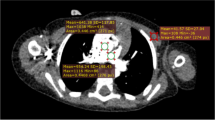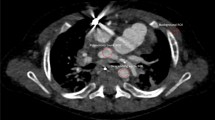Abstract
We wanted to compare the image quality and radiation dose of retrospective versus prospective ECG-gated dual-source CT imaging in pediatric patients with congenital heart diseases. We retrospectively evaluated 44 thorax CT images that were obtained using two different protocols (retrospective helical ECG-gated [n = 22] versus prospective non-helical ECG-triggering [n = 22]) in patients younger than 5 years. Two radiologists evaluated the image quality, using a 3- or 4-point scale, in terms of the degree of homogeneity of vascular enhancement, the stair-step artifacts, the subjective image noise and the overall subjective image quality. We compared the mean score of image quality, the frequency of marked stair-step artifact and the estimated radiation dose. The mean score of the homogeneity of vascular enhancement and the stair-step artifacts tended to be higher for the patients in the retrospective group than that for the patients in the prospective group, but this did not reach statistical significance. However, marked stair-step artifacts were significantly more frequent in the prospective scan group than that in the retrospective scan group (25.8 vs. 7.6%, respectively, P < 0.01). The mean scores for subjective image noise and the overall image quality were better in the retrospective group than those scores in the prospective group (P < 0.01). The mean estimated effective dose was higher for the retrospective ECG-gated helical scan than that for the prospective non-helical scan (0.79 vs. 0.21 mSv, respectively, P < 0.01). Retrospective ECG-gated helical dual-source CT using aggressive ECG pulsing can be obtained with an acceptable radiation dose and superior image quality, as compared to the prospective ECG-triggering technique, for the evaluation of congenital heart diseases in pediatric patients who are younger than 5 years old.


Similar content being viewed by others
Abbreviations
- MDCT:
-
Multi-detector computed tomography
- ECG:
-
Electrocardiography
- DSCT:
-
Dual-source computed tomography
- Bpm:
-
Beat per minute
- CTDIvol :
-
Volume CT dose index
- DLP:
-
Dose-length product
References
Hayabuchi Y, Mori K, Kitagawa T et al (2007) Accurate quantification of pulmonary artery diameter in patients with cyanotic congenital heart disease using multidetector-row computed tomography. Am Heart J 154(4):783–788
Goo HW, Park IS, Ko JK et al (2005) Computed tomography for the diagnosis of congenital heart disease in pediatric and adult patients. Int J Cardiovasc Imaging 21(2–3):347–365
Greil GF, Schoebinger M, Kuettner A et al (2006) Imaging of aortopulmonary collateral arteries with high-resolution multidetector CT. Pediatr Radiol 36(6):502–509
Oztunc F, Baris S, Adaletli I et al (2009) Coronary events and anatomy after arterial switch operation for transposition of the great arteries: detection by 16-row multislice computed tomography angiography in pediatric patients. Cardiovasc Intervent Radiol 32(2):206–212
Wang XM, Wu LB, Sun C et al (2007) Clinical application of 64-slice spiral CT in the diagnosis of the Tetralogy of Fallot. Eur J Radiol 64(2):296–301
Hollingsworth CL, Yoshizumi TT, Frush DP et al (2007) Pediatric cardiac-gated CT angiography: assessment of radiation dose. Am J Roentgenol 189(1):12–18
Hein F, Meyer T, Hadamitzky M et al (2009) Prospective ECG-triggered sequential scan protocol for coronary dual-source CT angiography: initial experience. Int J Cardiovasc Imaging 25(suppl 2):S231–S239
Petersilka M, Bruder H, Krauss B et al (2008) Technical principles of dual source CT. Eur J Radiol 68(3):362–368
Stolzmann P, Scheffel H, Schertler T et al (2008) Radiation dose estimates in dual-source computed tomography coronary angiography. Eur Radiol 18(3):592–599
Ketelsen D, Thomas C, Werner M et al (2008) Dual-source computed tomography: estimation of radiation exposure of ECG-gated and ECG-triggered coronary angiography. Eur J Radiol. doi:10.1016/j.ejrad.2008.10.033
Ben Saad M, Rohnean A, Sigal-Cinqualbre A et al (2009) Evaluation of image quality and radiation dose of thoracic and coronary dual-source CT in 110 infants with congenital heart disease. Pediatr Radiol 39(7):668–676
Kuettner A, Gehann B, Spolnik J et al (2009) Strategies for dose-optimized imaging in pediatric cardiac dual source CT. Rofo 181(4):339–348
Lerner CB, Frush DP, Boll DT (2008) Evaluation of a coronary-cameral fistula: benefits of coronary dual-source MDCT angiography in children. Pediatr Radiol 38(8):874–878
Landis JR, Koch GG (1977) The measurement of observer agreement for categorical data. Biometrics 33(1):159–174
Cademartiri F, Mollet NR, Runza G et al (2006) Improving diagnostic accuracy of MDCT coronary angiography in patients with mild heart rhythm irregularities using ECG editing. Am J Roentgenol 186(3):634–638
Hirai N, Horiguchi J, Fujioka C et al (2008) Prospective versus retrospective ECG-gated 64-detector coronary CT angiography: assessment of image quality, stenosis, and radiation dose. Radiology 248(2):424–430
Arnoldi E, Johnson TR, Rist C et al (2009) Adequate image quality with reduced radiation dose in prospectively triggered coronary CTA compared with retrospective techniques. Eur Radiol 19(9):2147–2155
Stolzmann P, Leschka S, Scheffel H et al (2008) Dual-source CT in step-and-shoot mode: noninvasive coronary angiography with low radiation dose. Radiology 249(1):71–80
McCollough CH, Primak AN, Saba O et al (2007) Dose performance of a 64-channel dual-source CT scanner. Radiology 243(3):775–784
Herzog C, Mulvihill DM, Nguyen SA et al (2008) Pediatric cardiovascular CT angiography: radiation dose reduction using automatic anatomic tube current modulation. Am J Roentgenol 190(5):1232–1240
Pages J, Buls N, Osteaux M (2003) CT doses in children: a multicentre study. Br J Radiol 76(911):803–811
Poll LW, Cohnen M, Brachten S et al (2002) Dose reduction in multi-slice CT of the heart by use of ECG-controlled tube current modulation (“ECG pulsing”): phantom measurements. Rofo 174(12):1500–1505
Acknowledgments
This study was supported by grant no 04-2008-085-0 from the SNUH Research Fund.
Author information
Authors and Affiliations
Corresponding author
Rights and permissions
About this article
Cite this article
**, K.N., Park, EA., Shin, Ci. et al. Retrospective versus prospective ECG-gated dual-source CT in pediatric patients with congenital heart diseases: comparison of image quality and radiation dose. Int J Cardiovasc Imaging 26 (Suppl 1), 63–73 (2010). https://doi.org/10.1007/s10554-009-9579-2
Received:
Accepted:
Published:
Issue Date:
DOI: https://doi.org/10.1007/s10554-009-9579-2




